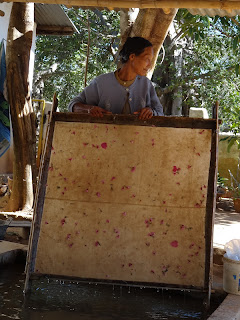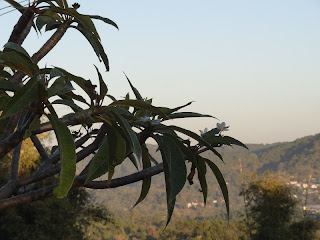Jan 14 Pindaya
Pindaya is famous for
it's 10,000 Buddha cave (so far it's only 8096 Buddhas in the cave,
but more on that later). Pindaya is also roughly 70km away from
Nyaungshwe on Inle Lake and a good three hour drive. Now
ponder that for a minute. 70 km, 3 hours. And then picture the
road conditions. Apart from the fact that it was going uphill the
road was mostly paved. Badly paved but nonetheless paved. It
continued holes of various sizes so it was b..um..py. Very bumpy. The
unpaved parts of the road will for sure be paved soon. Regularly you
will see a big group of men and women working on paving parts of the
roads, mostly financed by investments from foreign companies.
Everything goes by hand, except the flattening. Heating the tar,
distributing rocks of all sizes, placing them in shape, pouring the
hot tar. It is fascinating to watch. Incredible hard work. On the
more remote road stretches they even set up tents beside the road,
one for males, one for females, so the work can go on without too
many interruptions. I wonder how the road will look in a few years
from now. It also seems that only patches are being paved or
maintained. The patches that foreigners pay for. Other patches remain
bumpy dirt tracks.
While there is not much
traffic on the roads, the air nonetheless is full of particles and
seems extremely unhealthy to breathe in. The vehicles available are
all bad polluters. Mucus turns black after breathing here for a
while. You definitely wouldn't want to work at the roadside day in
and day out in these conditions. Over here they would have closed
everything down already to protect people's health. Different
countries, different measures. Here they are just happy they have
vehicles at all, whether they be donated from Japan, China, Thailand
or Korea. It makes a merry mix of left or right-hand drive vehicles,
although they do drive on the right side of the road.
Back to the caves. After
a seemingly endless drive uphill we reach the caves of 8096 Buddhas.
We share a minibus with 3 others from the guesthouse. 2 Taiwanese, 1
Chinese, Udo and I and negotiated a price of 70,000K for the full day
for all of us.
It is a natural cave and
Buddhas have been placed here for thousands of years, with more being
added regularly. The site itself is famous in Buddhism but it's
remoteness and the road conditions keep it under the tourist radar.
In peak season less than 500 people visit per day, only a handful of
which foreigners.
The cave is much smaller
than I expected which results in Buddhas being stacked on top of each
other. Impressive sight. 2 $ entry (for foreigners only) seems
reasonable here.
After the caves we visit
an umbrella making factory. The make their own paper from mulberry
tree bark, color it naturally, sometimes add flowers and make sun
umbrellas or lamp shades. I especially enjoy that they freely explain
their trade without any obligation to buy. Very rare these days.
Like all other foreign
visitors we are being shipped off to the same overpriced restaurant
for lunch before the long ride back starts.
We visit another cave
near Kalaw, which to me personally is more impressive. There are no
visitors here at all. The cave is long, stretching through a whole
mountain with a narrow alley passing through, Buddhas on either side
and stalactites and stalagmites lining up along the way. The
stalactites and stalagmites are still growing so it is a wet cave.
This makes the other four in the party turn back when they encounter
the wet ground. Unbeknownst to me I suspect them still behind me and
end up crossing through the whole cave by myself. No worries, the
path only leads one way anyway and comes out on the other side of the
hill just a few minutes walk back. I really enjoyed this. A little
cave, tiny adventure and no tourists around. So should you take the
difficult road to Pindaya, definitely stop at the Myin Ma Hti /Yevin
Cave Pagoda as well.























Keine Kommentare:
Kommentar veröffentlichen